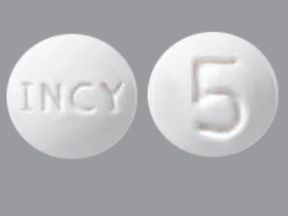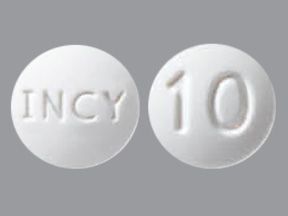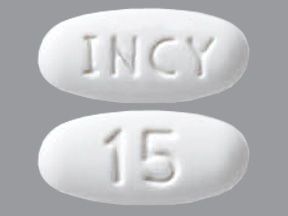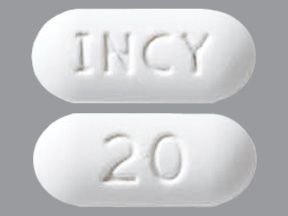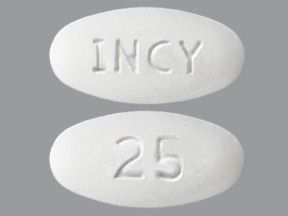Jakafi (ruxolitinib) is a prescription drug that’s used to treat graft-versus-host disease and certain kinds of cancer. Jakafi comes as an oral tablet.
Jakafi is used to treat:
- acute and chronic graft-versus-host disease (GVHD) in certain adults and some children
- polycythemia vera (a kind of blood cancer) in certain adults
- myelofibrosis (a kind of bone marrow cancer) in certain adults
To learn more about these conditions and how the drug is used, see the “What is Jakafi used for?” section below.
Jakafi basics
Jakafi comes as a tablet you swallow. It belongs to a drug class called kinase inhibitors. (A drug class is a group of drugs that work in a similar way.)
The active ingredient in Jakafi is ruxolitinib. (An active ingredient is what makes a drug work.) It’s not available in a generic form.
Read on to learn more about Jakafi’s side effects, dosage, uses, and more.
Like most drugs, Jakafi may cause mild to serious side effects. Below are lists of some of the more common side effects this drug may cause. But they don’t include all possible side effects.
Keep in mind that side effects of a drug can depend on:
- your age
- other health conditions you have
- other medications you take
- the condition you’re taking the drug to treat
Your doctor or pharmacist can tell you more about the potential side effects of Jakafi. They can also suggest ways to help reduce them.
Mild side effects
Here’s a list of some of the mild side effects Jakafi can cause. To learn about other mild side effects, talk with your doctor or pharmacist, or read the drug’s prescribing information.
Mild side effects of Jakafi that have been reported include:
- cough
- dizziness
- fatigue
- headache
- mild infection, such as:
- muscle spasms
- problems with digestion, such as:
- constipation
- diarrhea
- flatulence (gas)
- nausea
- shortness of breath
- skin rash
- swelling in various areas of your body
- weight gain
- mild allergic reaction*
Mild side effects of many drugs may go away within a few days to a couple of weeks. But if they become bothersome, talk with your doctor or pharmacist.
* To learn more about this side effect, see the “Allergic reaction” section below.
Serious side effects
Serious side effects from Jakafi can occur, but they aren’t common. If you have serious side effects from this drug, call your doctor right away. But if you think you’re having a medical emergency, call 911 or your local emergency number.
Serious side effects of Jakafi that have been reported include:
- cardiac (heart-related) side effects, such as:
- increased risk of blood clots*
- increased risk of specific cancers, including certain kinds of skin cancer
- low levels of specific blood cells, including:
- high levels of triglycerides and cholesterol
- high level of liver enzymes (a kind of protein), which could be a sign of liver damage
- high blood pressure
- severe infection, such as:
- severe allergic reaction†
You can refer to this Jakafi side effects article for details.
* This side effect wasn’t reported in Jakafi’s studies. But it has been reported with a different kinase inhibitor (the group of drugs Jakafi belongs to). To learn more about your risk of this side effect with Jakafi, talk with your doctor.
† To learn more about this side effect, see the “Allergic reaction” section just below.
Allergic reactionSome people may have an allergic reaction to Jakafi. While allergic reaction wasn’t reported in the drug’s studies, it can still happen.
Symptoms of a mild allergic reaction can include:
A more severe allergic reaction is rare but possible. Symptoms of a severe allergic reaction can include swelling under your skin, usually in your eyelids, lips, hands, or feet. They can also include swelling of your tongue, mouth, or throat, which can make it hard to breathe.
Call your doctor right away if you have an allergic reaction to Jakafi. But if you think you’re having a medical emergency, call 911 or your local emergency number.
Costs of prescription drugs can vary depending on many factors, including what your insurance plan covers and which pharmacy you use.
If you have questions about your price for Jakafi and how to pay for your prescription, talk with your doctor or pharmacist. You may also be eligible for a program called IncyteCARES that can help you find ways to save on Jakafi’s cost.
You can also check out this article to learn more about saving money on prescriptions.
Why is Jakafi so expensive?
Jakafi may be expensive due to many factors, including the cost of manufacturing and testing the drug. The cost can also depend on your insurance coverage and whether you qualify for financial support, such as the IncyteCARES program (see above).
You can refer to this Jakafi cost article for details.
Below are answers to some commonly asked questions about Jakafi.
What is Jakafi’s mechanism of action?
Jakafi’s mechanism of action (how the drug works) is to stop proteins called Janus kinases (JAKs) from working. JAK proteins help the body produce blood cells and are thought to make graft-versus-host disease, polycythemia vera, and myelofibrosis worse.
Jakafi is not chemotherapy or an immunosuppressant. It’s a type of targeted therapy called a kinase inhibitor. This means it targets specific things in the body, such as proteins, rather than affecting all cells in the body.
To learn more about how Jakafi works, you can talk with your doctor or a pharmacist.
How does Jakafi compare with the alternatives Inrebic and Hydrea?
Below are a few ways that Jakafi compares with fedratinib (Inrebic) and hydroxyurea (Hydrea).
Jakafi, Inrebic, and Hydrea are used to treat similar kinds of cancer.
Jakafi and Inrebic are used to treat myelofibrosis (a kind of bone marrow cancer). Both belong to a group of drugs called kinase inhibitors. They each work in a similar way to treat this condition.
Jakafi and Hydrea are used to treat polycythemia vera (a kind of blood cancer). While Jakafi is a kinase inhibitor, Hydrea is an antimetabolite drug. Each medication works in a different way to treat this condition.
To learn more about how Jakafi, Inrebic, and Hydrea compare, talk with your doctor.
How long can you take Jakafi?
How long you’ll take Jakafi depends on your condition and how well the drug works to treat it. If you and your doctor decide that Jakafi is safe and effective for your condition, you’ll likely take it long term.
But if your condition hasn’t eased after 6 months of Jakafi treatment, your doctor may have you stop the drug. In this case, they may recommend a different treatment option for your condition.
Your doctor can advise you on how long you should expect to take Jakafi.
Does Jakafi cause hair loss or weight gain?
Jakafi isn’t known to cause alopecia (hair loss), but it may cause weight gain.
Hair loss wasn’t reported as a side effect in studies of Jakafi. But graft-versus-host disease (GVHD), which Jakafi is used to treat, may cause hair loss. If you’re taking Jakafi for GVHD, you may notice hair loss. But this is likely to be caused by the condition instead of Jakafi.
Jakafi is known to cause weight gain. But this side effect was less commonly reported than others in studies of the drug.
If you have other questions about hair loss, weight gain, and Jakafi, talk with your doctor.
Can I develop long-term side effects from taking Jakafi?
Yes. Although rare, it’s possible to develop long-term side effects from taking Jakafi. Most side effects of this drug are temporary and only last a few days to weeks. And many of them will go away soon after you start or stop the drug.
But in rare cases, Jakafi may cause serious side effects that lead to long-term problems. Examples include:
- stroke*
- heart attack*
- increased risk of blood clots*
- possible increased risk of specific cancers, including certain kinds of skin cancer
It’s important to remember that the length of time Jakafi’s side effects last will differ from person to person. If you have more questions about Jakafi and its long-term side effects, talk with your doctor.
* These side effects weren’t reported in studies of Jakafi. But they have been reported with a different kinase inhibitor (the group of drugs Jakafi belongs to). To learn more about your risk of these side effects with Jakafi, talk with your doctor.
Does Jakafi cause specific side effects in people taking it to treat graft-versus-host disease (GVHD)?
It’s possible. In studies of Jakafi, certain side effects were only reported when the drug was used to treat GVHD. These side effects weren’t reported when the drug was used to treat polycythemia vera or myelofibrosis.
Below are examples of specific Jakafi side effects that may occur in people with GVHD:
If you have questions about what to expect with Jakafi treatment for GVHD, talk with your doctor.
If you have graft-versus-host disease (GVHD) or certain kinds of cancer, your doctor may prescribe Jakafi for you. Keep reading to learn about the conditions Jakafi is used to treat.
GVHD
Jakafi is used to treat acute and chronic GVHD in adults and children ages 12 years and older.
GVHD is a condition that can occur after a bone marrow transplant (also called a stem cell transplant). With GVHD, donated stem cells attack healthy cells in your body.
Acute GVHD
GVHD is considered “acute” when it occurs within 3 months of a bone marrow transplant. Symptoms of this condition include:
- high level of liver enzymes (a kind of protein), which could be a sign of liver damage
- problems with digestion, such as diarrhea and vomiting
- skin rash
Jakafi is used when acute GVHD has not eased after treatment with corticosteroids. Examples of corticosteroids include:
- methylprednisolone (Medrol)
- prednisone (Rayos)
Chronic GVHD
GVHD is considered “chronic” when it occurs between 3 months and 1 year of a bone marrow transplant. Symptoms of chronic GVHD include:
- hair loss
- dry eyes
- changes in your skin, such as scaling, dryness, or discoloration
- mouth ulcers (sores)
- liver damage
Jakafi is used when chronic GVHD has not eased after treatment with one or two other therapies. Examples of these treatments include:
- immunosuppressants, such as:
- tacrolimus (Astagraf XL, Envarsus XR, Prograf)
- sirolimus (Rapamune)
- corticosteroids, such as:
- methylprednisolone (Medrol)
- prednisone (Rayos)
Polycythemia vera
Jakafi is used to treat polycythemia vera (PV) in certain adults. PV is a kind of blood cancer that causes your body to make too many red blood cells. PV can lead to problems such as an enlarged spleen and blood clots.
Symptoms of this condition include:
- discolored skin
- bleeding or bruising more easily than usual
- fatigue
Jakafi can be used when PV has not eased after treatment with hydroxyurea (Hydrea, Droxia). Or it may be used when hydroxyurea caused side effects that were too severe or bothersome to keep taking it.
Myelofibrosis
Jakafi is used to treat specific kinds of myelofibrosis in certain adults. Myelofibrosis is a kind of bone marrow cancer. It keeps your body from making healthy blood cells.
Myelofibrosis can lead to problems such as low red blood cell levels and an enlarged spleen. Symptoms of this condition include:
- itching
- pain under your left ribs or in your belly
- bone and muscle pain
- night sweats
Jakafi can be used for the following kinds of myelofibrosis:
- primary myelofibrosis, which can happen on its own
- certain kinds of secondary myelofibrosis, which can happen as a result of:
- primary thrombocythemia (also known as essential thrombocythemia)
- polycythemia vera
Your doctor will recommend the dosage of Jakafi that’s right for you. Below are commonly used dosages, but always take the dosage your doctor prescribes.
Form and strengths
Jakafi comes as a tablet that you swallow. It’s available in several strengths:
- 5 milligrams (mg)
- 10 mg
- 15 mg
- 20 mg
- 25 mg
Recommended dosages
Your doctor will likely start you on a low dosage of Jakafi. They’ll adjust it over time until you reach a dosage that treats your condition without causing bothersome side effects.
Your Jakafi dosage will be based on several factors, including:
- your age
- the severity of the condition you’re taking it to treat
- any side effects you may have
- other medical conditions you have, such as kidney or liver problems
Before starting Jakafi and while your doctor is adjusting your dosage, you’ll have complete blood counts done regularly. Your doctor may recommend more blood tests depending on how your body responds to treatment.
Dosage for graft-versus-host disease
For acute graft-versus-host disease (GVHD), Jakafi’s starting dosage is 5 mg twice per day. After at least 3 days, your doctor may increase your dosage to 10 mg twice per day.
For chronic GVHD, Jakafi’s starting dosage is 10 mg twice per day.
For acute or chronic GVHD, after 6 months of Jakafi treatment, your doctor might taper (gradually lower) your dose every 8 weeks. This is to see whether your symptoms come back or get worse. If they do, your doctor may increase your dosage again. But, you should not stop taking Jakafi or change your dosage unless your doctor tells you to.
Dosage for polycythemia vera
For polycythemia vera, the starting dosage of Jakafi is 10 mg twice per day. After 4 weeks, your doctor might increase your dose, depending on how your body responds to treatment. Dose increases are done in 5-mg increments, twice per day, with at least 2 weeks between each increase.
The maximum dosage for polycythemia vera is 25 mg twice per day.
Dosage for myelofibrosis
For myelofibrosis, your Jakafi dosage depends on your platelet count. Your starting dosage might be any of the following, taken twice per day: 20 mg, 15 mg, or 5 mg. Your doctor will use blood tests to check your platelet levels before treatment and every 2 to 4 weeks during treatment. This will determine whether your dosage needs to be adjusted.
The maximum dosage for myelofibrosis vera is 25 mg twice per day.
Note: For details, you can refer to this Jakafi dosage article.
Questions about Jakafi’s dosing
Below are some common questions about Jakafi’s dosing.
- What if I miss a dose of Jakafi? If you miss a dose of Jakafi, you can skip it. Then you can take your next dose at its usual time. Do not take any extra doses of Jakafi to make up for a missed dose. Doing so can increase your risk of side effects from the drug.
- Will I need to take Jakafi long term? Whether you’ll take Jakafi long term depends on the condition you’re taking it for and how well the drug works to treat it. For details, see “How long can you take Jakafi?” in “What are some frequently asked questions about Jakafi?” above.
- How long does Jakafi take to work? Jakafi starts working right away to treat your condition, but you may not notice that it is. Your doctor may order certain tests while you’re taking Jakafi to confirm it’s effectively treating your condition.
Stopping Jakafi should not cause withdrawal syndrome or withdrawal symptoms. Withdrawal syndrome refers to side effects that can happen when you stop taking a drug your body is used to having.
But stopping Jakafi may cause symptoms of the condition you were taking the drug to treat to return within a few weeks. For this reason, you should not stop taking Jakafi without first talking with your doctor. If they determine it’s safe, they may slowly lower your dosage over time. This will help reduce the risk of symptoms of your condition returning. (For details about Jakafi’s dosage, see this article.)
If you have questions about the side effects of stopping Jakafi, talk with your doctor.
Before taking Jakafi, it’s important to talk with your doctor. Tell them about any medical conditions you have, your overall health, and any other drugs you take. These and other factors are described in more detail below.
Interactions
Taking a medication with certain vaccines, foods, and other things can affect how the drug works. These effects are called interactions.
Before taking Jakafi, be sure to tell your doctor about all drugs you take, including prescription and over-the-counter kinds. Also, describe any vitamins, herbs, or supplements you use. Your doctor or pharmacist can tell you about any interactions these items may cause with Jakafi.
For information about drug-condition interactions, see the “Warnings” section below.
Interactions with drugs or supplements
Jakafi can interact with several kinds of drugs. These include:
- certain antibiotics, such as:
- rifampin (Rifadin, Rimactane)
- erythromycin (Eryc, Ery-Tab, Eryped)
- certain antifungals, such as:
- fluconazole (Diflucan)
This list does not contain all kinds of drugs that may interact with Jakafi. Your doctor or pharmacist can tell you more about these interactions and any others that may occur with this drug.
Other interactions
In addition to the drugs listed above, you may need to avoid certain foods with Jakafi.
Specifically, it may be best to avoid grapefruit and grapefruit juice while taking this drug. Grapefruit can prevent your body from breaking down Jakafi as it should. And this can increase the level of the drug in your body, increasing your risk of side effects.
To learn more about how grapefruit may interact with certain drugs, read this article. Talk with your doctor if you have questions about eating certain foods with Jakafi.
You can also refer to this Jakafi interactions article to learn more.
Warnings
Jakafi can sometimes cause harmful effects in people with certain conditions. This is known as a drug-condition interaction. Other factors may also affect whether this drug is a good treatment option for you. Talk with your doctor about your health history before starting Jakafi. Factors to consider include:
- kidney problems
- liver problems
- history of infection, including:
- tuberculosis
- hepatitis B
- herpes zoster (chickenpox, shingles)
- herpes simplex
- allergic reaction
- increased risk of cardiac (heart-related) side effects such as heart attack and stroke, including:
Jakafi and alcohol
It should be safe to drink alcohol during treatment with Jakafi. If you have questions about consuming alcohol while taking this drug, talk with your doctor or pharmacist.
Pregnancy and breastfeeding
It’s not known whether Jakafi is safe to take while pregnant or breastfeeding. If you have questions about taking this drug during pregnancy or while breastfeeding, talk with your doctor.
Your doctor will explain how you should take Jakafi, including how much to take and how often. Be sure to follow your doctor’s instructions.
Taking Jakafi
Jakafi comes as a tablet that you swallow.
Accessible medication containers and labels
Certain pharmacies may provide medication labels that:
- have large print
- use braille
- contain a code you can scan with a smartphone to change the text to audio
Your doctor or pharmacist may be able to recommend a pharmacy that offers these options if your current pharmacy doesn’t.
Also, if you’re having trouble opening your medication bottles, let your pharmacist know. They may be able to put Jakafi in an easy-open container. They may also recommend tools to help make it simpler to open the drug’s container.
Questions about taking Jakafi
Below are some common questions about taking Jakafi.
- Can Jakafi be chewed, crushed, or cut in half? Jakafi’s manufacturer has not stated whether the tablets can be chewed, crushed, or cut in half. Because of this, it’s best to always swallow the tablets whole. If you have trouble swallowing tablets, check out this article or talk with your doctor or pharmacist.
- Should I take Jakafi with food? You can take Jakafi with food or without it.
- Is there a best time of day to take Jakafi? No, you can take the drug any time of day. But try to take your doses at about the same time each day. This can help keep a steady level of the drug in your body, which helps it work effectively.
Do not take more Jakafi than your doctor prescribes, as this can lead to serious side effects.
Symptoms of overdose
Symptoms caused by an overdose can include low levels of specific blood cells, including:
What to do in case you take too much Jakafi
Call your doctor if you think you’ve taken too much Jakafi. You can also call 800-222-1222 to reach America’s Poison Centers or use its online resource. But if you have severe symptoms, immediately call 911 or your local emergency number or go to the nearest emergency room.
Disclaimer: Healthline has made every effort to make certain that all information is factually correct, comprehensive, and up to date. However, this article should not be used as a substitute for the knowledge and expertise of a licensed healthcare professional. You should always consult your doctor or another healthcare professional before taking any medication. The drug information contained herein is subject to change and is not intended to cover all possible uses, directions, precautions, warnings, drug interactions, allergic reactions, or adverse effects. The absence of warnings or other information for a given drug does not indicate that the drug or drug combination is safe, effective, or appropriate for all patients or all specific uses.

